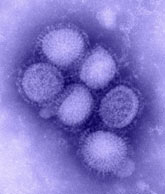
Handy Links
SLAC News Center
SLAC Today
- Subscribe
- Archives: Feb 2006-May 20, 2011
- Archives: May 23, 2011 and later
- Submit Feedback or Story Ideas
- About SLAC Today
SLAC News
Lab News
- Interactions
- Lightsources.org
- ILC NewsLine
- Int'l Science Grid This Week
- Fermilab Today
- Berkeley Lab News
- @brookhaven TODAY
- DOE Pulse
- CERN Courier
- DESY inForm
- US / LHC
SLAC Links
- Emergency
- Safety
- Policy Repository
- Site Entry Form

- Site Maps
- M & O Review
- Computing Status & Calendar
- SLAC Colloquium
- SLACspeak
- SLACspace
- SLAC Logo
- Café Menu
- Flea Market
- Web E-mail
- Marguerite Shuttle
- Discount Commuter Passes
-
Award Reporting Form
- SPIRES
- SciDoc
- Activity Groups
- Library
Stanford
Around the Bay
H1N1 Influenza: What Is It and How Do I Protect Myself?
With the beginning of fall and the start of school, it's time to prepare for flu season. This year, the new strain of influenza virus H1N1, formerly called "swine flu," deserves added caution. During the past several months, the experience in the Southern Hemisphere's flu season has indicated that H1N1 cases have a severity comparable to seasonal flu. However, SLAC and Stanford are preparing information and health support resources to help the community have a healthy season and to be prepared in the case of a more serious outbreak of the H1N1 virus.
For full details and information about this strain, symptoms, guidance, protection and more, the best reference is the U.S. Centers for Disease Control (CDC) 2009 H1N1 Flu Web site.
According to the CDC, the single best way to protect against the flu is to get vaccinated each year. Unfortunately the H1N1 strain is not susceptible to the normal seasonal flu vaccine, so a vaccine is under development for H1N1. The latest projections are that it will become generally available for the public late in October. In the meantime, SLAC's Medical Department will be administering the seasonal flu vaccine, for SLAC employees only, beginning in early October. An announcement will be made when the seasonal flu vaccines are available. Please be aware that certain people should not get a flu vaccine without first consulting a physician; these people are listed on the CDC Web site.
If there were to be a large-scale outbreak of H1N1 at the lab, or any other emergency situation, SLAC staff could find emergency information on the SLAC Emergency Web page and the SLAC Emergency Status telephone line (877-447-7522). To be ready in case of a large-scale flu outbreak, lab management is working on a plan to support critical operations in the event the lab needs to shut down by order of the local Public Health Department, based on guidance from Stanford University or based on the direct impact to our workforce.
SLAC and Stanford are providing a variety of resources to help the community respond to any threat of widespread illness. Stanford is offering a one hour interactive webinar: "Q&A—The Latest on the H1N1 Flu," at noon on September 29. It is free, though pre-registration is required (class code: flu-01).
To help prevent the spread of illness, SLAC Facilities will be installing hand sanitizers in convenient locations across the SLAC site in the coming weeks.
The SLAC Pandemic Influenza Web page will be updated as additional information becomes available from SLAC groups responsible for safety, health, human resources, facilities and communications. The updated site will be announced later this month. Also look for future SLAC Today articles and information sharing sessions from the SLAC Medical Department. In the meantime, here are some tips for staying healthy.
Where can I get the most current information about the spread of the pandemic influenza?
The best sources of current pandemic influenza information are the Web sites of the CDC and the World Health Organization. At SLAC, you can check the SLAC pandemic influenza Web page and the Medical Department H1N1Advisory page, as well as Stanford University's Influenza FAQ for more information and links.
How do I know if I have the flu or a simple cold?
Flu viruses generally come with higher temperatures than colds: 102 to 104 degrees F as opposed to below 101 degrees F. The flu, which generally comes on very quickly, is characterized by severe feelings of weakness, achiness, and fatigue. Flu often comes with headaches, while colds generally cause mild headaches from sinus congestion. Sneezing and nasal congestion are more common with colds than with the flu. Coughs are generally more severe with the flu, as are muscle aches.
Take these everyday steps to protect your health:
- Cover your nose and mouth with a tissue when you cough or sneeze. Throw the tissue in the trash after you use it.
- Wash your hands often with soap and water, especially after you cough or sneeze. Alcohol-based hand sanitizers with at least 62% alcohol, as will be available in the upcoming hand sanitizers at SLAC, are also effective.
- Avoid touching your eyes, nose or mouth. Germs spread this way.
- Try to avoid close contact with people who are ill.
- If you are sick with flu-like illness, Stanford's revised return to work policy for influenza-like illnesses requires that you remain at home until at least 24 hours after you are free of fever (100° F /38°C) or signs of fever (chills, flushed appearance, sweating), without the use of fever-reducing medications. These are based on the CDC recommendations, During this time, try to keep away from others as much as possible to avoid making others sick.
These steps will go a long way to minimize transmission of the flu virus, both seasonal and H1N1. Stay safe and healthy this winter at SLAC!
—Leslie Stepanek
SLAC Today, September 21, 2009
